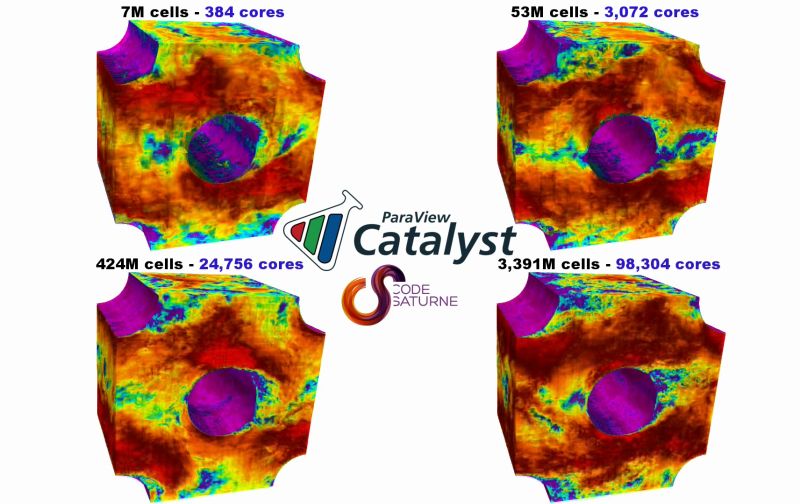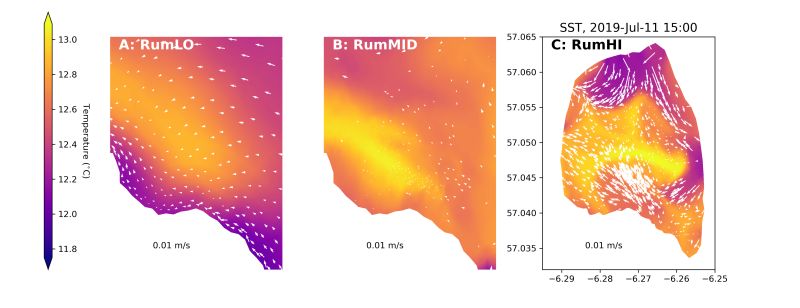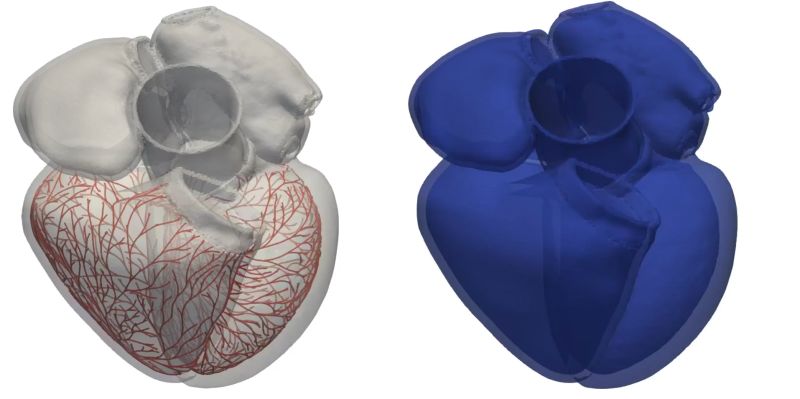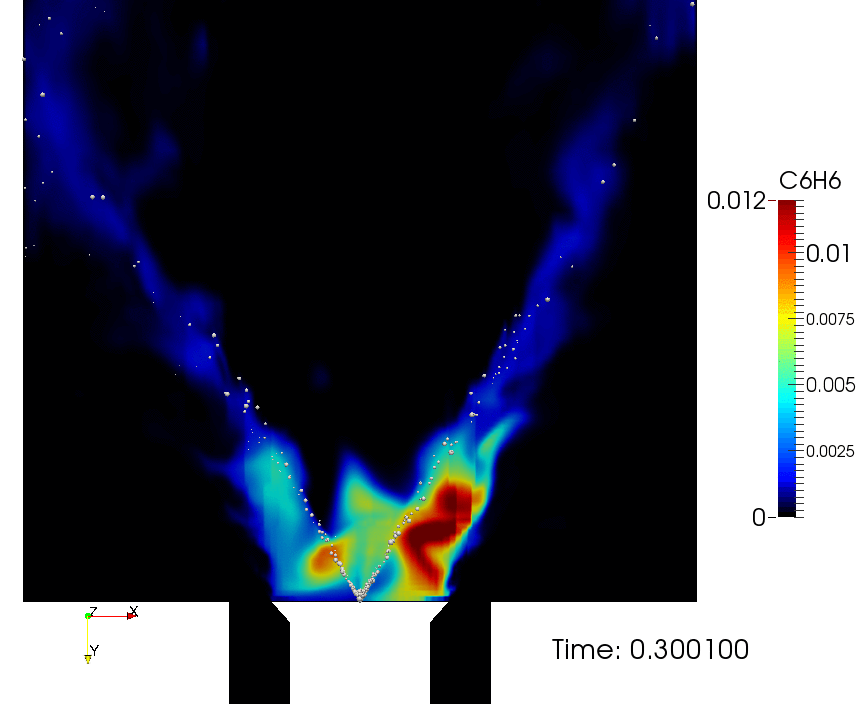1. Metadynamics simulations opening the active site of the SARS-CoV-2 main protease
Mohamed Ali Al-Badri & Khaled Abdel-Maksoud, King's College London, Department of Physics & University of Southampton, School of Chemistry
The main protease (MPro) of SARS-CoV-2 is an enzyme essential for virus replication through viral proteolytic activity and subsequent generation of infectious virus particles. Current computational efforts towards SARS-CoV-2 MPro inhibitor design have generally neglected an allosteric mechanism linked to His41-Cys145 catalytic dyad disruption and thus fail to target the open conformational state. We identify the rare event associated with the allosteric regulation of MPro activity in the orientation of the His41 imidazole side chain away from Cys145. In this video, we illustrate that molecular dynamics and metadynamics simulations sample this allosteric mechanism within a computationally feasible timescale, to aid in performing computer-aided MPro inhibitor design.
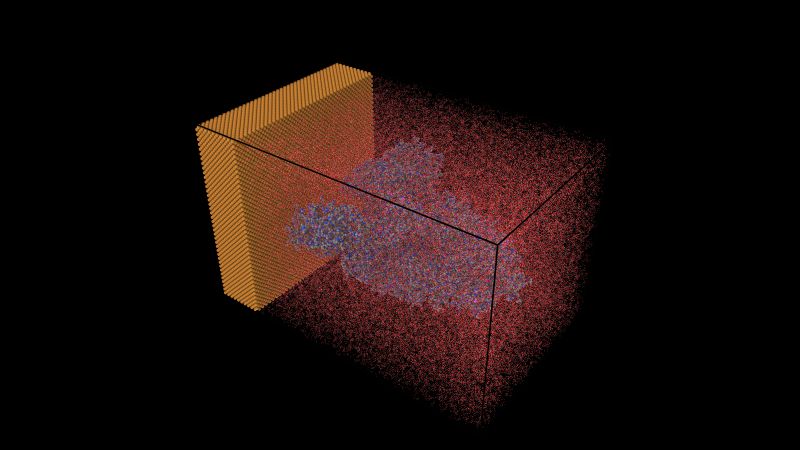
2. The 'spike' of SARS-CoV-2 near the (100) surface of copper.
Jonathan Bean & Jacob Lee, University of Cambridge, Department of Materials
This research is about trying to understand the relationships between different material surfaces and virus'. The image is of the solvated spike protien of SARS-CoV-2 near the (100) surface of copper. It was generated with the molecular dynamics code LAMMPS and was post-processed using the visualisation software OVITO using ray tracing methods.
3. In-situ visualisation at scale applied to Large Eddy Simulations in a heat exchanger tube bundle. Four mesh sizes are considered, going from 7 million cells (top left) to 3,391 millions cells (bottom right).
Charles Moulinec, STFC Daresbury Laboratory/SCD
High-fidelity turbulence simulations are performed in an elemental part of a heat exchanger tube bundle. The development of the flow is shown for 4 meshes of increasing size, each of the simulations being run using an optimal number of processors for the CFD software on ARCHER. The 4 animations that make the full video are obtained from frames generated on the fly by an in-situ visualisation library (catalyst) coupled with a solver (Code_Saturne). The largest simulation (bottom right animation) deals with an extremely large mesh of about 3.4 billion cells, and is run using about 90% of the full ARCHER (98,304 processors/4,096 nodes). The 151 generated frames amount for about 50 megabytes of data. In comparison, traditional postprocessing relying on dumping data on disk would require about 4.5 terabytes of data, making them nearly impossible to be dealt with. ffmpeg is used to generate the final video.
4. Tip leakage loss generation in an axial compressor stator blade.
Joshua Maynard, University of Cambridge, Engineering
The flow in an axial compressor that escapes through the clearance between the blade and rotating hub is known as the tip leakage flow. This video shows a radial and axial cut demonstrating the unsteady, turbulent nature of tip leakage flow in an axial compressor stator blade. Tip leakage flow accounts for up to 30% of loss in axial compressors. Loss which contributes to increased gas turbine fuel burn and therefore large environmental impact and cost, as gas turbines generate roughly 45% of UK energy. Entropy function is analogous to local lost work and dark blue areas, such as the flapping open separation in the tip gap, are high in loss. High fidelity computational fluid dynamics is a critical tool for building understanding of the flow behaviour as the complex phenomena are outside the scope of standard computational methods and geometric constraints make experimental measurements difficult.

5. Simulate the movement of Greenland on Archer.
Xueping Gao, University of Edinburgh, EPCC
This is a picture of the ISC 2020 student cluster competition. It simulates the movement of Greenland by building and running the glacier modeling software Elmer/Ice on ARCHER. This image shows the potential changes in Greenland in the future, helping us to better address climate change.
6. Symmetric instability in a cross-equatorial western boundary current
* * * Winning Video * * *
Fraser Goldsworth, University of Oxford, AOPP
Intense currents form on the western boundaries of Oceans - the North Brazil Current is one such example. The video shows the potential vorticity (PV) in an idealised model of this cross-equatorial current. PV is a measure of how fast and in which direction a fluid is rotating.
Here we see anticyclonic (clockwise) eddies being spun up as the fluid crosses the equator. They have negative PV (shown in blue) and become symmetrically unstable. The instability generates small scale features within the eddies and sets their PV to zero (shown in white).
The simulation is from work investigating how symmetric instability effects the North Brazil current. ARCHER was used to run the model - without it, it would not have been possible to resolve the small scale instabilities which make this work so interesting!

7. Endothelial glycocalyx -- defender of blood vessel walls
* * * Winning Early Career entry * * *
Xizhuo Jiang, University College London, Department of Mechanical Engineering
The lumen side of our blood vessel walls is covered by a tree-like structure called endothelial glycocalyx (EG). This image shows the EG conformation under blood flow conditions. In this research, a dissipative particle dynamics method is used to investigate the blood flow profile over the complex surface configuration with EG. All the simulations and post-processing are implemented on ARCHER.
The image is generated by VMD and trimmed in Adobe Illustrator.
8. Laser pulse undergoing self-focusing effects during the penetration into the underdense frontal region of a pre-expanded plasma target.
Pablo Jaime Bilbao Santiago, Physics Dept, Lancaster University & GoLP / Instituto de Plasmas e Fusão Nuclear, Instituto Superior Técnico
This movie depicts the electric field of an intense laser pulse (blue and red volumes) right before the laser is reflected by an overdense plasma (blue rear surface). The laser has penetrated the frontal underdense plasma region (transparent yellow), where it has coupled to the electrons heating them. Due to the collective non-linear effects of the plasma, the laser undergoes self-focusing within this underdense region. This is seen in the cross-section of the pulse (14 secs) where a clear pinching of the pulse is observed. This leads to an increase of the laser intensity on target, which in turn produces an enhanced electron heating.
The simulation, performed with the Particle-In-Cell code OSIRIS on ARCHER, uses laser and plasma conditions modelled after the L3IA experiment at CNR (Pisa, Italy). This work is used to understand and improve the generation of hot electrons in laser-plasma interactions, vital for laser-plasma based ion acceleration.

9. Simulating coastal current separation
Max Holloway, Scottish Association for Marine Science, Physics
A high-resolution ocean model simulation capturing current separation along the north-east coastline of the island of Rum, on the Scottish west coast. Panels A-F show simulated hourly sea surface temperature (SST) and current velocities during July 2019. The high-resolution simulation is nested within larger regional models (panel G) using the Finite Volume Community Ocean Model (FVCOM). This was undertaken as part of the OffAqua project, which is evaluating the environmental conditions required for the development of offshore aquaculture.
10. Simulating coastal current separation across scales
Max Holloway, Scottish Association for Marine Science, Physics
High-resolution ocean model simulations of sea surface temperature (SST) and current velocities, capturing current separation along the north-east coastline of the island of Rum, on the Scottish west coast. Each panel shows a different simulation using the Finite Volume Community Ocean Model (FVCOM) zoomed in on the Rum coastline around a fish farm. The resolution increases from left to right, with minimum element sizes of ~200 m (low resolution; panel A), ~30 m (panel B), and 5 m (highest resolution, panel C). The higher resolution simulations are nested within the lower resolution domains. As resolution increases, so does the emergence of new physical features in the flow, including coastal current separation events in the highest resolution domain (panel C). This was undertaken as part of the OffAqua project, which is evaluating the environmental conditions required for the development of offshore aquaculture.

11. Simulating coastal current separation across scales
Max Holloway, Scottish Association for Marine Science, Physics
High-resolution ocean model simulations of sea surface temperature (SST) and current velocities, capturing current separation along the north-east coastline of the island of Rum, on the Scottish west coast. Each panel shows a different simulation using the Finite Volume Community Ocean Model (FVCOM) zoomed in on the Rum coastline around a fish farm. The resolution increases from left to right, with minimum element sizes of ~200 m (low resolution; panel A), ~30 m (panel B), and 5 m (highest resolution, panel C). The higher resolution simulations are nested within the lower resolution domains. As resolution increases, so does the emergence of new physical features in the flow, including coastal current separation events in the highest resolution domain (panel C). This was undertaken as part of the OffAqua project, which is evaluating the environmental conditions required for the development of offshore aquaculture.
12. Physiological Electro-mechanics Simulation on a Four-chamber Hear
Marina Strocchi, Department of Biomedical Engineering, King's College London
The video shows simulated electrical activation (left) and mechanical contraction (right) of the heart. High-fidelity computational models of the heart are increasingly used to improve our understanding of human pathology and pathophysiology. Our research aims to build computer models for cardiac activation and contraction providing physiological activation and contraction dynamics. The simulation shown in the video includes fundamental features needed to simulate realistic cardiac function such as the Purkinje network (red network on the left), which leads to a fast activation of the bottom chambers of the heart, and the effect of the pericardium, a 'bag' containing the heart and limiting its motion. With our models, we are able to simulate therapy delivery in order to improve patient selection and optimise response to treatment.

13. Heat map of water on a Bassanite slab
Stephen Yeandel, Department of Materials Science and Engineering
The calculated average structure of a Bassanite (Calcium Sulphate Hemihydrate) slab, along with the calculated probability of finding a water oxygen atom at a given location on the surface and within the structure itself. The complex patterns appearing on the surface highlight local structuring of water on a scale inaccessible to experiments, but which can be obtained from atomistic simulations coupled with High-Performance Computers such as ARCHER. Understanding the atomic scale behaviour of water and other molecules at material surfaces has implications for a wide range of research areas including crystal growth and catalysis.

14. Particles surf on plasma waves excited by high-power lasers
* * * Winning Image and overall winner * * *
Nitin Shukla, Instituto Superior Technico
Particle accelerators are fundamental tools for science and society, enabling scientific discoveries and providing unprecedented insights into fundamental propterties of nature. Miniaturization of those machines would open the way to several applications, from light sources to cancer treatments. Laser wakefield acceleration is a promising candidate to achieve what is called a table-top electron accelerator. The idea is to use a powerful laser to excite a wave in a plasma, an ionized gas and exploit the strong accelerating fields of the wave to accelerate electrons. The picture depicts a laser pulse (in color) causing a strong modulation in the plasma density (in blue) and thus driving the plasma wave. An electron beam (witness bunch, in orange) is injected ito the latter and gets accelerated. The simulation has been performed with the Particle-In-Cell code OSIRIS on ARCHER in the framework of the HPC-Europa3 program.
15. Plasmoids in magnetic reconnection: evolving towards bigger size
Elisabetta Boella, Physics Department, Lancaster University
Magnetic reconnection is a physical process occurring in plasma, the most abundant form of ordinary matter in the Universe. It entitles a re-arrangement of the plasma magnetic field topology with the release of magnetic energy. The process is ubiquitous in space, where it is at the origin of the northern lights or where it plays a role in eruptive phenomena like solar flares.
The video depicts the formation of magnetic islands or plasmoids: closed regions of magnetic field separated by reconnection points. With time these plasmoids attract each other and combine becoming bigger and bigger. The simulation has been performed with the Particle-In-Cell code ECsim on ARCHER. This work shed light on the evolution of reconnection from microscopic kinetic scales to macroscopic scales in perturbed and unperturbed current sheets. It thus helps to improve our understanding of the physics of the inner heliosphere.
16. Soot precursor benzene (C6H6) from a commercial jet fuel spray flame shown in a cross-section of a lab-scale burner
Jenna Foale, University of Cambridge, Department of Engineering
Liquid fuels -- gasoline, diesel, and kerosene -- power most transportation. As the world begins to transition to lower-carbon fuel sources, we must do our best to reduce emissions from the fossil fuels which power our vehicles in the meantime. With Archer's computational power we can solve fluid mechanics and combustion chemistry equations to predict benzene (C6H6) production, a major species producing soot in flames used to power aircraft (benzene is shown in the gaseous field cross-section of a burner). Using detailed chemistry for liquid kerosene spray (shown as white droplets), we can adapt combustion models to predict soot and emission production from both conventional and alternative jet fuels at both stable and extreme in-flight operating conditions. These efforts will reduce emissions from aviation until fossil fuels are no longer needed for commercial flight.

17. Symmetric and anti-symmetric bypass transition induced by plamsa actuation
Dandan Xiao, Department of Engineering, University of Nottingham
Bypass transition in a boundary layer flow induced by a pair of DBD plamsa actuators is presented. By varying the distance between the two actuators, two forms of instabilities and subsequently the scenarios of transition, namely a symmetric one and an anti-symmetric one, are observed from Direct Numerical Simulations (large figures). These are confirmed by non-modal studies revealing the transient dynamics of perturbations leading to the onset of transition (small figures)
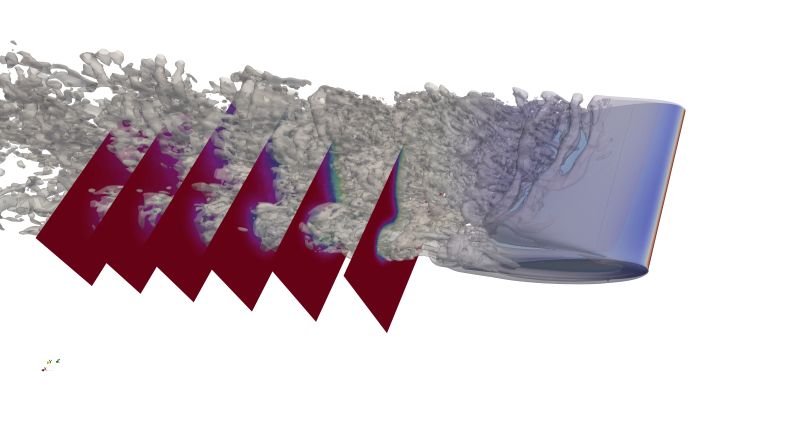
18. Spatial evolution and dissipation levels of a wingtip vortex in an incompressible turbulent flow
Juan Carlos Bilbao-Ludena, Department of Aeronautics, Imperial College London
Some of the enduring enigmas and mysteries of turbulence are encoded in the high-order statistical moments which can be accessed solely through Direct Numerical Simulation (DNS) or advanced experimental techniques. The image shows a DNS simulation of a wingtip vortex where the instantaneous velocity field is visualized with the use of the Q-criterion through contour planes showing dissipation magnitudes of the turbulent flow along the streamwise direction. Using Archer's capability of 375 cores, a 30 million cells simulation has been performed with our group's in-house code PANTARHEI. This configuration represents a flow with a high level of anisotropy where the prevalence of the wingtip's vortical structure can be observed in detail. The understanding of the vortex evolution in terms of high-order statistics in the near wake region is of great importance for the improvement of civil aviation safety standards now with the introduction of unmanned aircraft and higher saturated airspace.
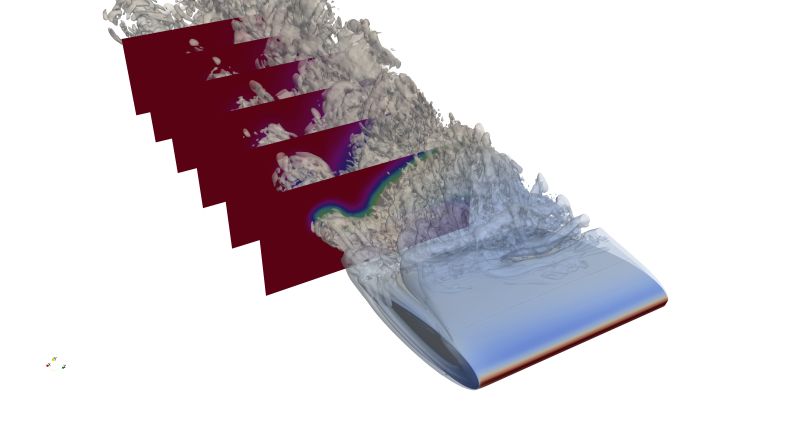
19. Spatial evolution and dissipation levels of a wingtip vortex in an incompressible turbulent flow
Juan Carlos Bilbao-Ludena, Department of Aeronautics, Imperial College London
Some of the enduring enigmas and mysteries of turbulence are encoded in the high-order statistical moments which can be accessed solely through Direct Numerical Simulation (DNS) or advanced experimental techniques. The image shows a DNS simulation of a wingtip vortex where the instantaneous velocity field is visualized with the use of the Q-criterion through contour planes showing dissipation magnitudes of the turbulent flow along the streamwise direction. Using Archer's capability of 375 cores, a 30 million cells simulation has been performed with our group's in-house code PANTARHEI. This configuration represents a flow with a high level of anisotropy where the prevalence of the wingtip's vortical structure can be observed in detail. The understanding of the vortex evolution in terms of high-order statistics in the near wake region is of great importance for the improvement of civil aviation safety standards now with the introduction of unmanned aircraft and higher saturated airspace.


